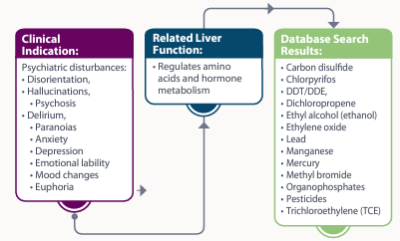Assessing Clinical Indicators of Detoxification
Photo Cred: Magic mine/Shutterstock
By Kim Furtado, ND
The best way to truly know that liver detoxification support could help a patient is to understand what role the liver is playing in the symptom picture. This requires a good working knowledge of liver function. Many commonly treated conditions are not overt liver diseases, but the liver has a role in the pathophysiology.
In addition, since some toxins are classified as endocrine disrupting chemicals, symptoms related to endocrine disruption could indicate a need for clinical detoxification. This relates to reproductive health, diabetes, thyroid disorders, and adrenal concerns. Toxins classified as neurotoxins, immune toxins, carcinogenic, reproductive toxins, obesogens, and metabolic dysregulators can have a role in those related symptom pictures. The underlying factor of diseases observed from pollutant exposure is oxidative stress and inflammation. In my practice, all those related pathologies are clinical indications for detoxification.
Critical Thinking Process
Step One: Think about liver function and ask how the patient’s symptom picture or diagnosis relates to one or many of the liver’s functions.
Albumin production: Creates osmotic balance in blood, but also carries hormones, vitamins, and enzymes through the body. Relates in general to many conditions and hormone issues.
Bile production: Bile is critical for digestion and absorption of fats in small intestine. Fats are critical for good nerve function.
Filters blood and removes toxins: Through first pass effect, all blood leaving gastrointestinal tract passes through liver to remove toxins, byproducts and other harmful substances. This function is relevant to many clinical diseases associated with toxins.
- Hormone metabolism: Critical role in peripheral conversion of thyroid hormone and steroid hormone metabolism
- Processes glucose: Liver removes excess glucose from blood, stores as glycogen, and can also convert it back to glucose.
- Regulates amino acids: All protein production in body relies on amino acids and are needed for neurotransmitters, antibodies, and more.
- Regulates blood clotting: Bile from liver is required for absorption of Vitamin K, critical for blood clotting components and cholesterol production.
- Resists infections and regulates immune system: Filters microbes from blood stream and influences immune function with antibody production, nutrients, and other factors
- Stores vitamins and minerals: Significant amounts of vitamins A, D, E, K, B12, as well as iron and copper are stored in liver. Relates to many conditions. Vitamin D particularly influential of cellular proliferation and directly relates cancer risks.
Step Two: By connecting the symptom picture to liver function, investigate what toxins are associated with the disease by using the collaborative for health and environment’s disease and toxicant database. for example:

Step Three: Assess body burden with appropriate tests guided by the search results and address clinical needs through improving the related liver functions. focus clinical detoxification on removing identified toxins as able.
- For example, heart disease, including high blood pressure, high cholesterol, stroke, and myocardial infarction, is highly influenced by liver function. The complex interactions between the heart and liver have been well-documented, as in in the journal Cells. Recall the effects of Non-alcoholic Fatty Liver Disease (NAFLD) and the connection is clearer. Insulin resistance, sub-clinical inflammation, oxidative stress, ectopic fat deposition, atherosclerosis, and endothelial dysfunction all characterize pathophysiology of NAFLD. Cholesterol production and metabolism is one of the critical functions the liver performs. To treat heart disease while ignoring liver function is untenable once the pathophysiology is truly understood.
Editor’s Note: This text was originally published in the E-Book, An Introduction to Clinical Detoxification in Integrative Medicine. To access the full text, click here.
















